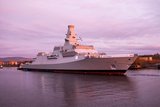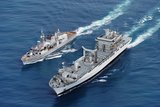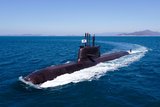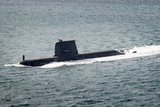HMS Glasgow taking shape
The Royal Navy’s first Type 26 frigate, the future HMS Glasgow, is taking shape at BAE Systems’ yard in Govan, Scotland.
Work on the £1.2 billion warship has been underway since mid-July 2017. The navy intends to acquire eight City-class vessels to replace its anti-submarine warfare Duke-class Type 23 frigates from the middle of the next decade.
At the Govan shipyard the vessel is being constructed in two sections - first the forward part of the frigate, followed by the stern. The two parts will be joined on the slipway outside the shed and the main mast and bridge section will be lifted into place. Following this, the frigate will undergo outfitting at BAE’s yard on the north bank of the Clyde at Scotstoun, Glasgow. Upon completion, the vessel will consist of 60 blocks.
BAE Systems is on order to build three vessels: Glasgow, Cardiff and Belfast. The remaining five vessels in the class have been named as Birmingham, Sheffield, Newcastle, Edinburgh and London.
Related Equipment in Defence Insight
More from Naval Warfare
-
![How will the Canadian Coast Guard’s transfer to the DND umbrella affect its capabilities?]()
How will the Canadian Coast Guard’s transfer to the DND umbrella affect its capabilities?
By joining the defence department, the coast guard will need to acquire new solutions and adapt its in-service capabilities to ensure interoperability with the Canadian Armed Forces.
-
![UK MoD’s confirmation of MBDA missile for Type 26 points to more European collaboration]()
UK MoD’s confirmation of MBDA missile for Type 26 points to more European collaboration
The Type 26 will also be fitted with the Sea Ceptor vertically launched air defence system that can fire CAMM missiles and a 24-cell Mk 41 vertical launch system that can fire the Tomahawk land-attack cruise missiles, anti-submarine rockets and long-range anti-ship missiles.
-
![Second Royal Canadian Navy Joint Support Ship is on schedule to be launched mid-2026]()
Second Royal Canadian Navy Joint Support Ship is on schedule to be launched mid-2026
While the first Joint Support Ship is currently in the final stages of outfitting, the second one is on schedule for launching next year.
-
![Is South Korea finally being taken seriously for Western submarine programmes?]()
Is South Korea finally being taken seriously for Western submarine programmes?
South Korean shipbuilders are beginning to make their mark beyond Asia, competing for major North American and European submarine programmes and becoming serious contenders on a global scale.
-
![AUKUS Pillar 2 could narrow focus to “four key areas” says UK official]()
AUKUS Pillar 2 could narrow focus to “four key areas” says UK official
Few concrete ideas have emerged so far on which “advanced capabilities” will be brought forward under Pillar 2 of the AUKUS partnership, but the Pentagon’s review of the programme could bring more clarity.
























